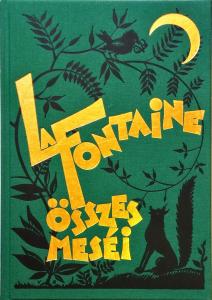
La Fontaine’s Complete Tales
La Fontaine’s Complete Tales
Entire Hungarian edition
Illustrated by Jenő Haranghy
Translated by Andor Kozma, Béla Vikár, Árpád Zempléni
Facsimile edition of the original published in 1929 (NSZL Collections)
NSZL, Budapest, 2017., 396 pages
ISBN 978 963 200 664 2
Jean de La Fontaine was a man of letters and a bon vivant of the glorious 17th century France, a contemporary of Louis XIV the Sun King, Racine, Molière and Boileau. Literary history, rather generously, places him culturally somewhere between Montaigne and Voltaire, and considers him the purest poet of that century apart from Racine. Out of his rich life-work of theatre plays, elegies, versed novels and narrations, it is his tales that are most recognized, and not without reason. He followed the customs and aesthetical standards of his time borrowing the contents of his animal tales in great part from Aesop, Phaedrus and the folk tale treasury of the East, but he did not disregard Boccaccio, Tasso or Machiavelli either. However, the popularity of La Fontaine’s tales is due to the fact that he was able to transmit the contents to his contemporary audience with unique freshness, vivid colors and the most appropriate wording.
The protagonists of these fables often written in dialogue are animals that usually follow their own nature, but it can easily be paralleled with human traits and forms of behavior, that tells about the feebleness of man and the morals of society. La Fontaine’s tales always represent human relations, and take a standpoint in societal questions or even current affairs. They do so in an apparently hidden way, but it is never too hard for us to understand the author’s allusions and opinion. All the more so as he always summarizes the moral in one or two lines at the end of the story, preventing us from getting lost in the maze of his human-animal world made up of envy, selfishness, deceit and conceit. The verdict of the poet offers the reader the uplifting sensation of that although the world is unjust, art can be all right.
The fables were published in 12 volumes, the first six of which the author dedicated to the young royal prince in 1668. As accustomed in that era’s literature, the didactic purpose is revealed already in the preface: „And to our human selves their sermons suit. / ’Tis thus, to come at man, I use the brute.” (Translated by Elizur Wright). In these volumes we can find famous tales like The Grasshopper and the Ant, The Raven and the Fox, The Two Mules, and The City Rat and the Country Rat. The following six volumes dedicated to Madame de Montespan, the official courtesan of Louis XIV expressing La Fontaine’s „enthusiastic gratitude”, include tales more suitable for adult readers. As the titles reveal, apart from the world of animals here we find also abstract stories with allegorical figures like Death and the Dying, The Women and the Secret, and The Fool who Sold Wisdom.
Our volume is a facsimile edition of the first complete collection of La Fontaine’ tales translated into Hungarian by Béla Vikár, Andor Kozma and Árpád Zempléni in the original order of the 12 books, published in 1926. But the Hungarian interest in La Fontaine’s work dates back to much earlier. The first Hungarian translator of the French author was poet and literary translator József Péczeli, a clergyman of the Reformed Chuch, whose collection [Entertaining and Useful Tales] of 1788 already included some La Fontaine adaptations. Then, a number of selections of La Fontaine’s tales were published during the 19th century, the first and most significant being a volume of the [Illustrated Publications by Gusztáv Heckenast] series in 1857, with the translations by Imre Lovász revised by Gergely Czuczor „following the original French”. Due to its quality illustrations, this book has had several editions. The short tales of moral dilemmas were perfectly suitable for educational purposes at the turn of the 19th and 20th century, as it is shown by Lipót Pálóczy’s 1877 edition with lexical and grammatical explanations and a vocabulary, and Leopoldina Gross’s 1903 selection with explanations and written exercises. As both works were dedicated for the higher grades of secondary schools to help learning French, they display the texts in their original language.
Perhaps because of the 1867 “bi-centenary” illustrations by Gustav Doré, La Fontaine’s tales were finally released from the „prison” of moral teaching, and became objects of artistic delight and interpretation. Hungarian poets and literary translators of the first half of the 20th century might have found an inspiring challenge in the French fables, as apart from Ödön Jakab and the three translators of our present volume also Dezső Kosztolányi published his seven translations (including The Raven and the Fox and The Stage Coach and Fly) in the first volume of the 1921 [Modern Poets] series. The artistic quality and poetic strength of the fables is emphasized in the preface by Miklós Radnóti for his selection of twenty tales published in 1943 within the [Bilingual Masterpieces] series of the Franklin Publishing House. Radnóti, a poet who during World War II was desperately looking for human orientation in the roots and past of the European culture and seeking comfort in the classical forms, found in La Fontaine a great poet and a master of the form. „Because he is an amazing poet. Bold and self-conscious. Proud of the how, as the what is nothing. […] La Fontaine knew exactly that giving form is what matters. He who borrowed from Aesop, Phaedrus and ten more, wrote the tale of The Jay Decked in Peacock’s Feathers on plagiarizing writers, and the introductory lines of Shepherd and Lion, conscious that »Adding some little touches now and then»” is the very essence of artistic creation.”
However, the laurels for traslating La Fontaine’s complete tales, a long years’ work, go to Béla Vikár and his two fellow translators. Our edition also boasts the vivid and often humorous illustrations by Jenő Haranghy that show the animal and human nature of the exemplary tales that La Fontaine wrote in his expressive and elegant style always with a forgiving and distant smile. And the same way as text and image make this book published between the two world wars complete, the tales are also made up by two parts, as La Fontaine himself said: „the body is the subject-matter of the fable, and the soul is the moral.”
*
With this classical book, the publishing workshop at National Széchényi Library pays tribute to the author of the fables that by now have become integral part of the Hungarian world of tales. At the same time we take this occasion to start a popular series of facsimile editions that brings back to the readers the printed form of one-time classics, works by popular authors and rare editions hardly available today.
Shopping
Our publications are available in our bookshop, or can be ordered from the Publications Department of the NSZL using the contact details below: Főigazgatói Kabinet kiadványtára, Országos Széchényi Könyvtár, 1276 Budapest P.O. box 1205., phone: 06-1-23-23-506, e-mail: kiadvanytar@oszk.hu.




